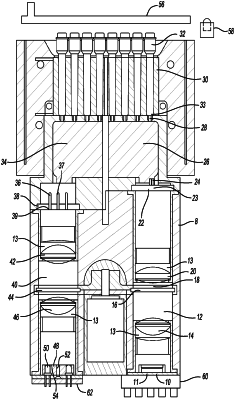| CPC G01N 21/6428 (2013.01) [C12Q 1/686 (2013.01); G01N 21/645 (2013.01); B01L 7/52 (2013.01); C12Q 2561/113 (2013.01); C12Q 2563/107 (2013.01); G01N 2201/062 (2013.01); G01N 2201/068 (2013.01)] | 13 Claims |

|
1. An instrument for performing polymerase chain reaction with real-time detection comprising:
a sample holder configured to receive one or more sample that each have at least one portion that is generally optically transparent, and that receives a biological sample comprising a nucleic acid to be amplified and at least one fluorescing agent that interacts with the nucleic acid during amplification and that emits light upon excitation by light of a known wavelength;
at least one light emitting diode device that is carried on at least one support substrate and is in electrical communication with a power source, and is adapted to emit light at a plurality of different wavelengths and arranged to emit light in a light pattern;
at least one photodiode array detector adapted to issue signals based upon intensity of light it receives;
a filter wheel including at least one filter pair such that one filter in each pair is an emission filter and one filter in each pair is an excitation filter;
a first excitation doublet lens disposed within the excitation path, the first excitation doublet lens stationary with respect to the filter wheel;
a second excitation doublet lens disposed within the excitation path, the second excitation doublet lens disposed on an opposite side of the filter wheel as the first excitation doublet lens; and
an array of fiber optic bundles, each of the fiber optic bundles having a first end aligned with a light spot of the light pattern of the at least one light emitted diode device and a second end aligned with one of the samples.
|